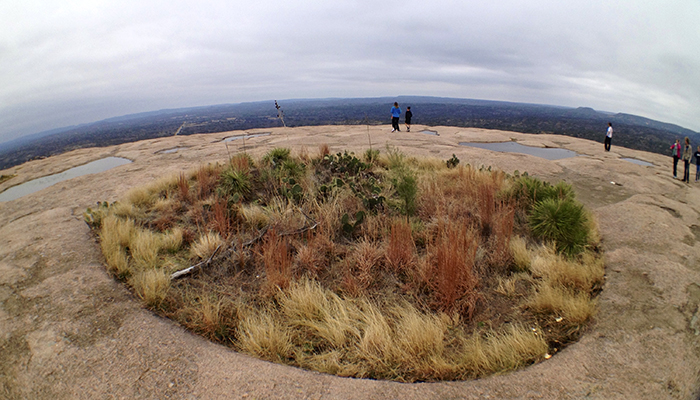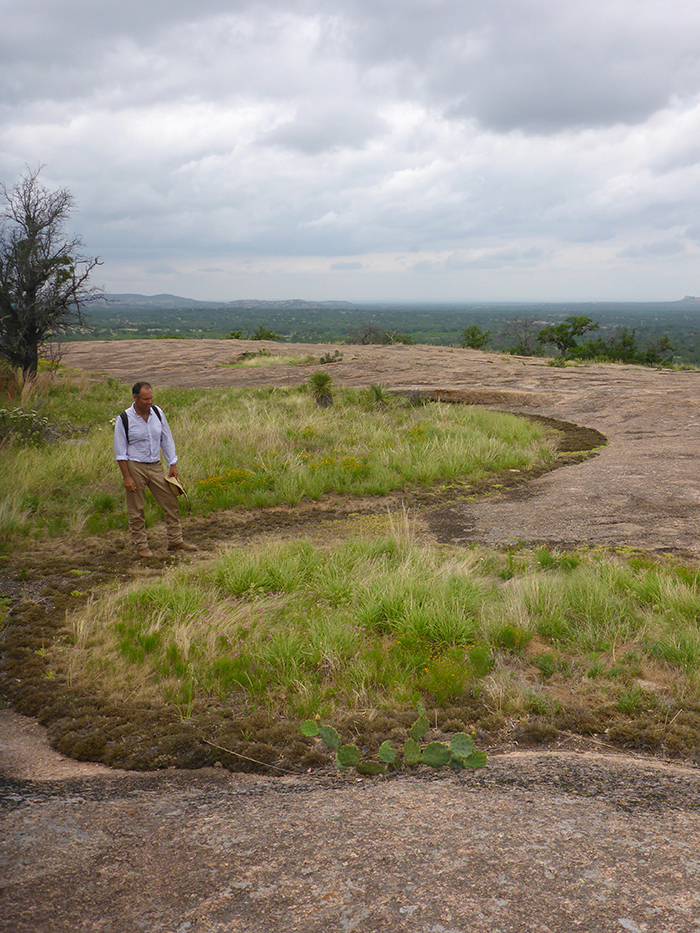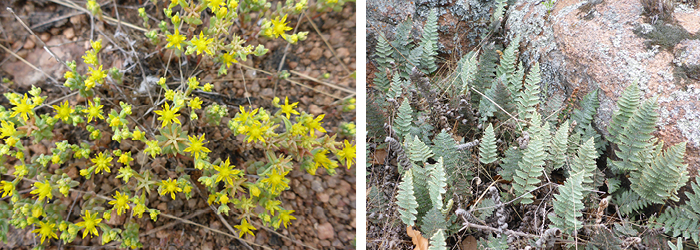On the Rocks

Plant communities like this one dot the surface of Enchanted Rock. PHOTO Lee Clippard
ASK A CENTRAL TEXAN where they take guests for a nature fix and the Enchanted Rock State Natural Area often tops the list. The eponymous granite dome is less than a two-hour drive from the capitol, near quaint, tourist-haven Fredericksburg. Steady breezes greet visitors on hot summer days as they reach the top of the dome, where they find soaring views of the tree-scattered Edwards Plateau below.
Enchanted Rock acquired its name centuries ago based on legends of Native Americans who found refuge atop the dome and considered it a sacred, protective space. Another name from the annals of history, “Crying Rock,” may stem from the way the 425-foot tall pink granite dome moans when it shrinks during a cool evening that follows a day of baking sunlight.
Tour guides also tell visitors that the rock’s granite is kin to that quarried just 30 minutes away in Llano, Texas, which became the polished façade of the Texas State Capitol. Enchanted Rock’s granite has been exposed over thousands of years, and extreme climate conditions continue to erode the billion-year-old rock. Features such as sunken areas where water pools, and dust and rock have become a nutrient-light soil, support little bluestem (Schyzachyrium scoparium) and other hardy natives.
What even Texans might not know is that Lady Bird Johnson helped ensure this historic landscape remained undeveloped. Back in 1978, Enchanted Rock was purchased from a landowner by The Nature Conservancy to be set aside for posterity at her urging. In 1984, two years after she helped found the Wildflower Center, Texas Parks and Wildlife bought the land and opened the 1,643-acre tract where visitors can hike, camp, bird watch and more.

Dr. Mark Simmons, who directs the Center’s Ecological Research and Design group, stands between pockets of vegetation at Enchanted Rock. PHOTO Michelle Bright
Elevated Learning
Now, ecosystem designers at the Wildflower Center are looking at plants that occur in the same environment as that at Enchanted Rock in an effort to see if those plants could grow in extreme urban environments. In particular, they are studying which native Southwestern plants could thrive on green roofs that also offer just a few inches of soil and sit atop buildings baking in the sun.
“The conditions are extreme in the Enchanted Rock area,” says Michelle Bright, an environmental designer for the Center. “There are high winds, and when it rains, it’s pretty intense rain. There are also heat and drought, so it’s similar to what could be experienced by plants on a skyscraper.”
To inform more than a decade of green roof studies, Bright and Dr. Mark Simmons, the Center’s Ecosystem Design Group director, visited the Schoolar Ranch last spring. It is located just north of Fredericksburg and has plants in similar habitats to the protected ones at Enchanted Rock. With the family’s permission, they collected about a dozen native species from the higher points of the 4,800-acre ranch for the early phase of this study, which has yet to be funded. They have since been evaluating how these natives perform when kept in flat beds at the Center that contain special media to mimic the rocky, thin soils of their origin.
The researchers seek to find natives that not only handle extreme conditions, but can be propagated fast under horticultural conditions. Or the plants may adapt well to other realities of living on engineered green roofs in the Southwest, the researchers’ specialty and the type of green roof they have consulted on for Austin and Dallas clients. For instance, these plants may experience bouts of no water when a building owner faces municipal water restrictions.
Bright notes that the plants under study can go dormant to handle such a scenario. “When watered, within a few minutes to an hour, they can completely green up again,” she says.

Center staff are studying specialized plants growing on granite at Schoolar Ranch to identify their preferred growing conditions. A flowering sedum (left) was found in open areas with very shallow soil. At right, this fern was found in crevices. PHOTO Michelle Bright.
Granite Communities
In visiting the ranch, Bright and Simmons paid particular attention to where plants were growing, what vegetation they shared space with and soil depths. “Some of the sedums and such just had a half inch of soil depth,” Bright says, “which is pretty remarkable.” By comparison, natives growing on a green roof atop the Center’s admission kiosk have four inches to root into under milder growing conditions.
The scientists found that lichens, moss and some other natives at the ranch’s higher elevations occurred in thinner soil just beginning to form from degraded granite. Rock crevices with deeper, more evolved soils that likely receive more moisture tended to harbor grasses such as little bluestem (Schizachyrium scoparium). Ferns favored pockets between rocks where they received some shade and moisture. Prickly pear (Opuntia engelmannii), meanwhile, held sway everywhere from crevices to gravel-strewn beds to bald rock surfaces.
The plant community patterns they cataloged, Bright notes, resemble those observed by a female botanist who visited Enchanted Rock back in the 1930s. Eula Whitehouse published a study on the evolution, or succession, of plant communities there as part of her doctoral research at UT.
“We’re doing something very similar,” Bright says “to what we’ve done when designing landscapes at the Bush Presidential Center in Dallas, Mission Reach in San Antonio and other projects. We’re learning how to create healthier landscape communities by directly observing natural systems and then pulling out the most appropriate ecological elements. These elements can be studied and then used in our built environments, including green roofs.”

